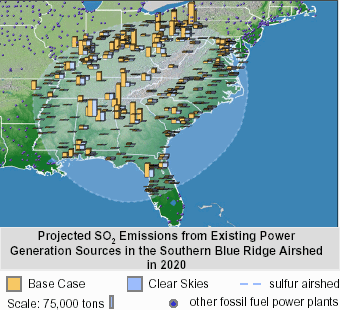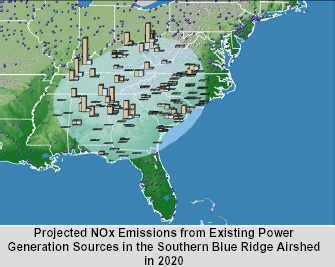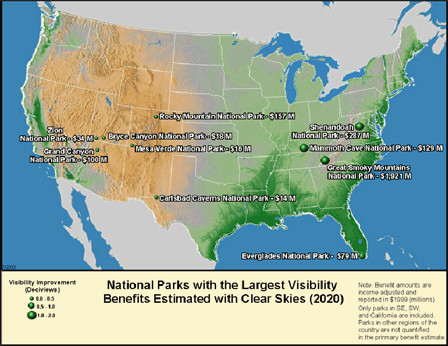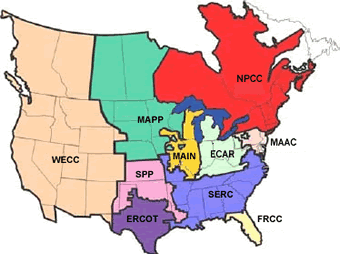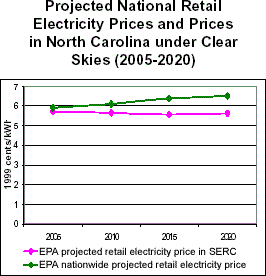Clear Skies
Clear Skies in North Carolina
1.25 MB PDF Version (18 pages)
Highlights of Clear Skies in North Carolina

- North Carolina’s Clean Smokestacks Act will substantially reduce emissions of SO2 and NOx in the State.
- Clear Skies builds on North Carolina’s Clean Smokestacks Act to achieve additional emission reductions in the state, particularly for mercury; an additional 17% reduction in NOx and 43% reduction in mercury by 2020 due to Clear Skies. Clear Skies also achieves substantial emissions reductions in neighboring states, which the Clean Smokestacks Act cannot accomplish.
- By 2020, North Carolina would receive approximately $5.8 billion in annual health benefits from reductions in fine particle and ozone concentrations alone due to Clear Skies (an alternative estimate projects $1 billion in health benefits in North Carolina). This includes 700 fewer premature deaths (400 under the alternative estimate) and 800 fewer hospitalizations/emergency room visits for asthma.
- North Carolina would receive environmental benefits, including reductions in acid deposition that will benefit forests and streams in the Appalachian Mountains and reductions in nitrogen deposition that will benefit the state’s coastal waters.
- Clear Skies does not significantly impact electricity prices. With or without Clear Skies, electricity prices in the electricity supply region that includes North Carolina are expected to remain below 2000 prices.
Clear Skies: An Innovative Approach to Improving Human Health and the Environment
Why Clear Skies?
- Air quality has improved, but serious concerns persist
- North Carolina citizens suffer ill effects from air pollution, including asthma attacks and premature death
- Statewide efforts, like the Clean Smokestacks Act, cannot reduce emissions from neighboring states
- Electricity generation sector remains a major emissions source
- Very cost-effective to control the power sector, relative
to other sources
- Sources are concerned about upcoming complex and burdensome regulations
- Very cost-effective to control the power sector, relative
to other sources
Advantages of the Clear Skies Approach
- Guarantees significant nationwide emissions reductions –
beginning years before full implementation
- Sources in North Carolina and nearby states would substantially
reduce emissions of SO2, NOx, and mercury
- Delivers dramatic progress towards achievement of critical health and environmental goals
- Sources in North Carolina and nearby states would substantially
reduce emissions of SO2, NOx, and mercury
- Uses proven, market-based flexible approach with incentives
for innovation
- Recognizes environmental needs as well as industry constraints,
allowing industry to better manage its operations and finances
while lowering risks to the public
- Sources are projected to install pollution controls to enable continued reliance on coal
- Recognizes environmental needs as well as industry constraints,
allowing industry to better manage its operations and finances
while lowering risks to the public
- Increases certainty across the board for industry, regulators,
and consumers
Under Current Clean Air Act Power Plants Would Face a Complex Set of Requirements

For a larger image, click here.
Clear Skies Sets a Firm Timeline for Emission Reductions
| The existing Title IV SO2 cap-and-trade program provides an incentive and a mechanism to begin reductions upon enactment of Clear Skies years before regulatory action under the current Act. |
2004: The NOx SIP call (summertime NOx cap in 19 Eastern States + D.C.)
2008: Clear Skies NOx Phase I (2.1 million ton annual cap assigned to two Zones with trading programs)
2010:
- Clear Skies Hg Phase I (26 ton annual cap with a national trading program)
- SO2 Phase I (4.5 million ton annual cap with a national trading program)
2018:
- Clear Skies NOx Phase II (1.7 million ton annual cap assigned to two Zones with trading programs)
- Clear Skies Hg Phase II (15 ton annual cap with a national trading program)
- Clear Skies SO2 Phase II (3.0 million ton annual cap with a national trading program)
Emissions in North Carolina under Clear Skies
|
Emissions in North Carolina (2020) would be significantly reduced from 2000 levels by the combined efforts of the Clean Smokestacks Act and Clear Skies:
These reductions are mostly attributable to the Clean Smokestacks Act, with the exception of mercury, which is reduced by another 43% beyond what North Carolina’s rule would achieve in 2020. |
Emissions: Current (2000) and Existing Clean Air Act Regulations (base case*) vs. Clear Skies in North Carolina in 2010 and 2020
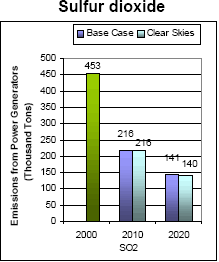
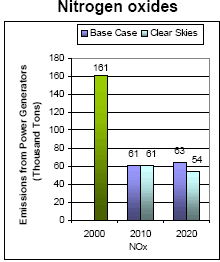
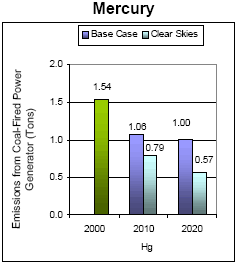
Note: The base case in IPM includes Title IV, the NOxSIP Call, NSR settlements, and state-specific caps in CT, MA, MO, NC, NH, TX, and WI. It does not include mercury MACT in 2007 or any other potential future regulations to implement the current ambient air quality standards or other parts of the Clean Air Act. Base case emissions in 2020 will likely be lower due to state and federal regulatory actions that have not yet been promulgated.
Emission Reductions under Clear Skies
| Emissions in North Carolina and surrounding states would decrease considerably. These emission reductions would make it much easier for North Carolina to maintain compliance with the national air quality standards. |

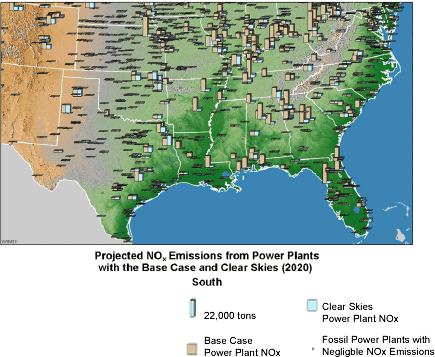
Note: The base case in IPM includes Title IV, the NOx SIP Call, NSR settlements, and state-specific caps in CT, MA, MO, NC, NH, TX, and WI. It does not include mercury MACT in 2007 or any other potential future regulations to implement the current ambient air quality standards or other parts of the Clean Air Act. Base case emissions in 2020 will likely be lower due to state and federal regulatory actions that have not yet been promulgated. Emissions projected for new units in 2020 are not reflected.
Clear Skies Health Benefits in North Carolina
Improve Public Health
| By 2020, North Carolina would receive approximately $5.8 billion in annual health benefits from reductions in fine particle and ozone concentrations alone due to Clear Skies. (See note 1.) |
- Reduced ozone and fine particle exposure by 2020 would result
in public health benefits of:
- approximately 700 fewer premature deaths each year
- approximately 500 fewer cases of chronic bronchitis each year
- approximately 1,000 fewer non-fatal heart attacks each year
- approximately 1,500 fewer hospital and emergency room visits each year
- approximately 88,000 fewer days workers are out sick due to respiratory symptoms each year
- approximately 5,400 fewer school absences each year
- Reduced mercury emissions would reduce exposure to mercury through
consumption of contaminated fish, resulting in additional, unquantified
benefits for those who eat fish from North Carolina lakes, streams,
and coastal waters.
Counties Projected to Remain Out of Attainment with the PM2.5 and Ozone Standards in North Carolina
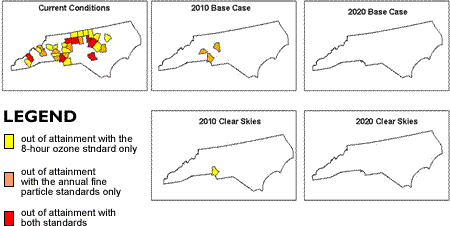
- Catawba, Davidson, and Mecklenburg counties are projected to remain out of attainment with the annual fine particle standard in 2010 with the Base Case but would attain the standard under Clear Skies.
- Mecklenburg County is projected to be out of attainment (ozone concentration=85ppb) with the ozone standard with Clear Skies in 2010 but is in attainment by 2020.
Note: Based on 1999-2001 data of counties with monitors that have three years of complete data. The base case includes Title IV, the NOx SIP Call, the Tier II, Heavy-Duty Diesel, and Nonroad Diesel rules, final NSR settlements as of early spring 2003, and state-specific caps in CT, MA, MO, NC, NH, TX, and WI. It does not include mercury MACT or any other potential future regulations to implement the current ambient air quality standards or other parts of the Clean Air Act.
Clear Skies Will Help North Carolina Meet Air Quality Standards
- Currently there are 15 counties exceeding the annual fine particle
standard and 22 counties exceeding the 8-hour ozone standard.
- All of these counties are expected to be brought into attainment
with the fine particle standard under existing programs.
- All of these counties are expected to be brought into attainment with the ozone standard under existing programs.
- All of these counties are expected to be brought into attainment
with the fine particle standard under existing programs.
- Clear Skies would significantly improve air quality in North
Carolina beyond what is expected from existing programs.
- By 2010, Clear Skies would bring all 3 remaining non-attainment counties (Catawba, Davidson, and Mecklenburg--population approximately 1 million) into attainment with the annual fine particle standard.
- By 2020, all counties are projected to be in attainment with both the annual fine particle and 8-hour ozone standard.
- In addition, Clear Skies would reduce ozone and fine particle concentrations in counties throughout the state.
Note: Based on 1999-2001 data of
counties with monitors that have three years of complete data.
Airsheds for the Southern Blue Ridge Mountains
This section shows regional airshed maps that were developed for the Southern Blue Ridge Mountains (which includes Shenandoah National Park).
- Multiple emission sources in numerous states contribute to air quality degradation and acid deposition in the Southern Blue Ridge region.
- In 2020, emissions from power plants in the Southern Blue Ridge region are projected to be substantially lower with Clear Skies than under the Base Case:
- SO2 emissions are projected to decrease 61%;
- NOx emissions are projected to decrease 68%.
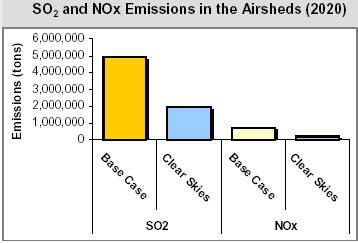
Note: An airshed depicts a modeled approximation of a large proportion of sources contributing to air quality in a particular receptor region.
Visibility Benefits in National Parks
Clear Skies Environmental Benefits in North Carolina
Projected Changes in Nitrogen Deposition with the Base Case in 2020 Compared to 2001
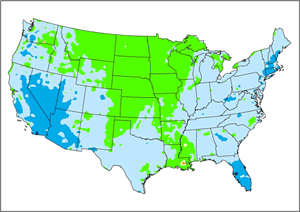
Projected Changes in Nitrogen Deposition with Clear Skies and
the Base Case in 2020 Compared to 2001
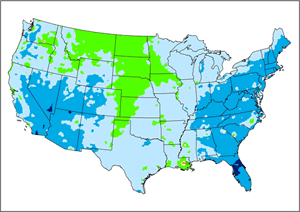 |
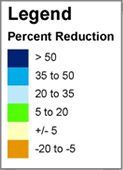 |
Note: Alaska and Hawaii are not included in the model domain
Clear Skies Would Provide Substantial Environmental Benefits in North Carolina
In comparison to existing programs,
- Visibility would improve perceptibly.
- The value of this benefit for great Smoky Mountain National
Park is $1.9 billion.
- The value of improved visibility for various Wilderness
Areas in North Carolina (Swanquarter, Shining Rockand Linville
Gorge Wilderness Areas) would be millions of dollars.
- The value of this benefit for great Smoky Mountain National
Park is $1.9 billion.
- Sulfur deposition, a primary cause of acid rain, would decrease
30-60% in the Appalachian Mountains of North Carolina.
- Nitrogen deposition, another significant contributor to acid
rain as well as a cause of damage in nitrogen-sensitive forests
and coastal waters, would decrease 20%.
- Mercury deposition would decrease up to 15% throughout most
of the state.*
* These results are based on modeling the Clear Skies mercury cap without triggering the safety valve.
Electricity Generation in North Carolina under Clear Skies
| Current and Projected Generation by Fuel Type
in North Carolina under Clear Skies (GWh) |
|
|
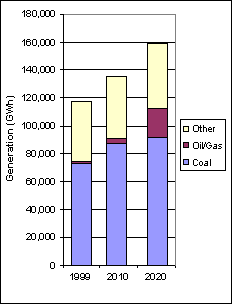 |
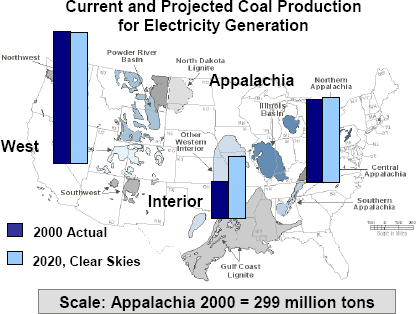
North Carolina’s electricity
growth is projected to be met by increases in gas-fired and
coal-fired generation. Clear Skies does not significantly alter
this projection.
|
Emission Controls in North Carolina under Clear Skies
|
State information based on EPA's modeling of the Clear Skies Act of 2002 is presented here for archival reasons.
|

